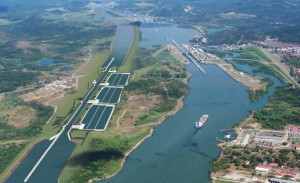Shipping in Panama is one of the most important drivers of the country’s economy. As a major transportation hub and a strategic location, Panama is uniquely positioned to play a key role in global trade. Throughout all of the country’s modern history, shipping has played an integral role in shaping Panama’s economy, infrastructure, population growth, and culture. In this blog post, we’ll take a closer look at the shipping industry in Panama, its relationship with the Panama Canal, and its impact on the overall economy of the country.
The powerful role of the Panama Canal
The Panama Canal is one of the most famous engineering feats in history. Completed in 1914, the canal is a 48-mile-long waterway that connects the Atlantic and Pacific Oceans. The canal allows ships to bypass the long and dangerous journey around the southern tip of South America, known as Cape Horn, and instead travel through Panama, saving both time and money.
The canal has played a significant role in the shipping industry in Panama. It is one of the busiest shipping routes in the world, with over 14,000 ships passing through the canal each year. The canal is also a major source of revenue for the country. In 2019, the canal generated $2.6 billion in revenue, accounting for around 6% of Panama’s GDP.
The Panama Canal Authority (ACP) is responsible for the operation and maintenance of the canal. The ACP is an autonomous government agency that oversees the management, regulation, and maintenance of the canal. The ACP has invested heavily in the modernization of the canal, with a $5.25 billion expansion project completed in 2016. The expansion allowed larger ships to pass through the canal, increasing its capacity and competitiveness.
The shipping industry in Panama
The shipping industry in Panama is closely linked to the Panama Canal. The country’s location and infrastructure make it an ideal location for maritime trade. Panama’s ports, including the ports of Balboa and Colon, are some of the busiest in Latin America. They handle a wide variety of goods, including containerized cargo, bulk cargo, and petroleum products.
The shipping industry in Panama is dominated by two major players: the Panama Canal Authority and the Panama Maritime Authority (AMP). The AMP is responsible for the regulation and promotion of the shipping industry in Panama. It oversees the registration of ships and the licensing of maritime service providers, such as shipping agents and brokers. The AMP also provides a range of services to the shipping industry, including vessel inspections, maritime education, and research.
Panama’s shipping industry has undergone significant growth in recent years. In 2020, Panama ranked as the world’s second-largest flag state, with over 8,000 registered vessels. The country’s open registry system, which allows foreign ships to register under the Panamanian flag, has been a key factor in this growth. The registry offers a range of benefits, including low registration fees, minimal taxes, and flexible regulations.
The impact of shipping on Panama’s Economy
The shipping industry in Panama is a major contributor to the country’s economy. It accounts for around 25% of Panama’s GDP and provides employment for thousands of people. The industry’s growth has also led to significant investment in infrastructure and services, including port facilities, logistics, and maritime education.
The Panama Canal is a key driver of the shipping industry’s impact on the economy. The canal’s revenue has allowed for significant investment in the country’s infrastructure and public services. The canal’s expansion project, for example, generated thousands of jobs and spurred growth in the construction and engineering sectors. The canal’s revenue also helps to fund social programs, including education and healthcare.
The shipping industry’s impact on the economy extends beyond the canal. The industry’s growth has led to increased investment in port facilities and logistics. This, in turn, has created new jobs and business opportunities. Panama’s ports, for example, are major employers in the country, providing jobs for thousands of workers and supporting thousands of more families. As this industry continues to thrive, so does the country around it, and that’s great news for Panama overall. To learn more about shipping in Panama, Panama’s economy, and how to relocate to Panama, contact us here now.
